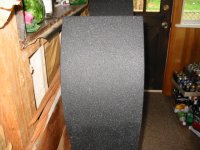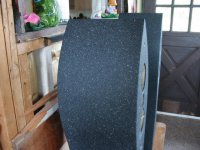Which to use? Lacquer must be sprayed and best done professionally. We spray top quality acrylic lacquer. Poly can be brushed so is touted for do-it-yourselfers.
Polyurethane:
A brushable finish widely touted to the do-it-yourselfer as the "be all" finish that is suppose to be water proof and superhard. The problem is that it is a thick finish that frequently shows brush marks and turns yellow with age. It is a hard finish but hard also means brittle, a finish that flakes, scratches and chips easily as a result, and is not repairable. Because it is rigid it does not flex with the wood and so any normal wood expansion creates hairline flaws, allowing moisture to get underneath causing white areas and finish lifting. When the finish does deteriorate, as it will eventually, it is extremely difficult to strip and refinish.
Lacquer:
It a finish that normally must be sprayed and is widely used by furniture manufacturers and refinishers. It is water clear and never changes color. It is repairable. With the acrylic additive that we use, it is flexible. It becomes the most moisture, alcohol, chip and scratch resistant finish you can use.
Water-based Lacquer:
Many furniture manufacturers now use water based lacquer in order to meet EPA regulations. It takes on a slightly cloudy or milky look, is very thin and brittle, and easily damaged. It is only moderately repairable.
Brushable Lacquer:
There is a brushable lacquer product by Deft brand called "clear wood finish" that is a brushable lacquer that exists. It smells terrible while curing and it takes at least three coats. It is what we recommend to the DIYer. The secret to using it is to use a very good brush and apply thin coats. Minwax also makes such a product.
Lacquer versus Polyurethane
it is actually not very knowledgeable description of Polyurethane behavior btw Polyurethane is widely used for floor finishing
the only what I can see is that "the experts" try to push people to use they service! there is no fair business...
"Lacquer must be sprayed and best done professionally. We spray top quality acrylic lacquer."
it is actually not very knowledgeable description of Polyurethane behavior btw Polyurethane is widely used for floor finishing
the only what I can see is that "the experts" try to push people to use they service! there is no fair business...
"Lacquer must be sprayed and best done professionally. We spray top quality acrylic lacquer."
Sam Maloof, the famous furniture designer and builder, who recently passed on, used a finish using polyurethane, tung oil and bees wax, IIRC.
Lacquer certainly doesn't have to be sprayed, 3,000 years of Japanese and Chinese artisans will back me up on that one. As I pointed out in a similar thread, automobiles were originally painted with brushes. Lacquer dries rapidly, so successive coats could be applied one after another. As labor cost started to rise, spray painting was invented to speed up the process, not as some would have it, to give a superior finish.
I'm old enough to know that the best looking automobile finishes were done with nitrocellulose lacquer, not acrylic lacquer, I've used both and the nitro (it smells like bananas) is far superior as a finish. It's an extremely hard finish which can give an incredible rubbed out finish, however it can crack and rock chips were common, which Acrylic isn't nearly as prone to do. Have you ever been to an antique auto show? Don't tell me that there's one acrylic finish on the grounds, as it's not only not authentic, but inferior as well.
For painted MDF speaker cabinets, I'll use polyurethane, it's really tough, it rubs out to a fairly decent shine and it can be refinished. The clear finishes over a wood surface? Well, personally I'd use something else, like shell lac. But that's just my perference.
However, YMMV.
Best Regards,
TerryO
I'm old enough to know that the best looking automobile finishes were done with nitrocellulose lacquer, not acrylic lacquer,
Best Regards,
TerryO
The world of painyt has changed a lot and IMO modern paints, which are of course optimized to be sprayed, are vastly supperior to those of the "old days". Its not like the big paint companies have not been doing anything for the last 20 years. Just look at the research of a company like Akzo Nobel and what they do. Modern finishes are vastly supperior in durability. But these days no pros "paint" with spray, they use electro finishes, many times completely dry.
It isn't that new. I saw powder coated speakers almost 20 years ago.
20 years ago the powder coating was universally thermally cured. Not true today.
Another option, depending on the finish you want, would be the DIY pickup truck bed liner that is now available at automotive parts centers. I have never tried it myself, but it should be durable.
Foam rollers do a superb job, put it takes some practice. I used to coat fine art prints with a protective acrylic top coat using a foam roller. One you get the hang of it, it can look just as good as spray.
Hint: use almost no pressure, just the weight of the roller. For acrylic, anyway.
Hint: use almost no pressure, just the weight of the roller. For acrylic, anyway.
The world of painyt has changed a lot and IMO modern paints, which are of course optimized to be sprayed, are vastly supperior to those of the "old days". Its not like the big paint companies have not been doing anything for the last 20 years. Just look at the research of a company like Akzo Nobel and what they do. Modern finishes are vastly supperior in durability. But these days no pros "paint" with spray, they use electro finishes, many times completely dry.
Earl,
You're most certainly right in that modern finishes are far superior in durability. This is perhaps "the" foremost function of a protective finish. But it isn't the only function.
Di Vinci didn't use gesso and oil to protect a board anymore than Turner used watercolors to protect paper. The goal or function of those mediums wasn't durability or protection. If it was, then the modern finishing materials are certainly far superior.
What I was getting at was that the older formulas and techniques are in some ways still unrivaled for ease of use and/or for the finest finish.
Just as some people can't imagine building anything, even a birdhouse, without Norm Abram's shop, a Scandinavian boatbuilder can turn out a beautiful boat with an axe, hammer, hand drill and a knife. He'd probably want a knotted string and copper nails as well, so the level of this technology is already at a high level.
So, if durability and protection of MDF Speakers is the goal, then I would imagine, from a cost and ease of use point of view, that roofing tar would be just about as good as anything, although I find that a skim coat of raw Bondo to be more attractive. The problem is, would you or anyone you know want that in your home?
You mention that the "Pros" don't spray paint anymore. That may come as a surprise to those that watch the "Hot Rod" shows on TV. I seem to remember that they were spraying the paint, but I'm not to date on this, so things may have changed in the last couple of weeks.
Best Regards,
TerryO
Another option, depending on the finish you want, would be the DIY pickup truck bed liner that is now available at automotive parts centers. I have never tried it myself, but it should be durable.
I've used it from spray cans and it's pretty good, and although I used it on my tool box, I know several that have used it on speaker canbinets and were very happy with the results.
Best Regards,
TerryO
Doesn't even have to be truck bed liner. This stuff comes in a spray can from your local hardware store and costs about $20 CAD to do two medium sized cabinets.
Hmmm... maybe that's what Terry was talking about Cal.
Cal,
The brand I used was Duplicolor which is pretty easy to find, at least down here.
Best Regards,
TerryO
Hi Richie,
Pictures deceive. It is like an indoor version of truck bed liner. Quite rubbery indeed. A little softer than truck liner in fact.
Cheers.
Pictures deceive. It is like an indoor version of truck bed liner. Quite rubbery indeed. A little softer than truck liner in fact.
Cheers.
- Status
- Not open for further replies.
- Home
- Loudspeakers
- Multi-Way
- MDF finishing -- absolute best method

